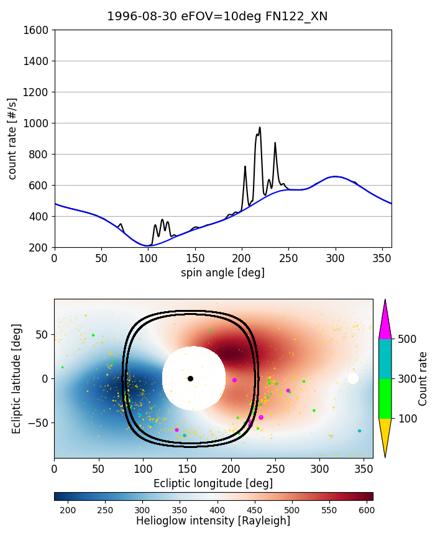GLOWS (GLObal solar Wind Structure) is one of experiments on a NASA mission IMAP (Interstellar Mapping and Acceleration Probe), scheduled for launch into a Lissajous orbit around the Lagrange point L1 in 2024 (McComas, et al., 2018) . The objective of GLOWS is to investigate the global heliolatitude structure of the solar wind and its evolution during the solar cycle. Additionally, GLOWS investigates the distribution of interstellar neutral hydrogen (ISN H) and the solar radiation pressure acting on ISN H.
The objectives of GLOWS are accomplished by observation of the heliospheric hydrogen backscatter glow (the helioglow). The helioglow is created by resonant excitation of ISN H atoms within several au from the Sun by the intense solar electromagnetic radiation in the Lyman-α waveband 121.557 nm. The H atoms move in this region collisionless and thus immediately after excitation of the photons from the Sun, they re-emit them in random directions. Those re-emitted photons form the helioglow. The intensity of the helioglow observed at ∼1 au varies across the sky, dependent on the location of the observer; it is on the order of 300–1000 Rayleigh.
The density and atom velocities of ISN H are governed on one hand by the solar radiation pressure in the Lyman-α line and solar gravity, and on the other hand by ionization losses. The responsible ionization processes include charge exchange between ISN H atoms and charged particles forming the solar wind particles (mostly protons and alpha particles), photoionization by solar radiation with wavelengths shorter than the threshold for H ionization at ∼91.2 nm, and, within 1–2 au from the Sun, by impact-ionization by solar wind electrons (Bzowski, et al., 2013).
The solar wind features a latitudinal structure that evolves during the cycle of solar activity. During low activity, it has a region of relatively slow and dense outflow (∼400 km s−1, ∼5 protons cm−3 at 1 au) in a heliolatitude band around solar equator. At polar heliolatitudes, the solar wind is fast (∼ 750 km s−1) and rarefied (∼ 2.5 protons cm−3 at 1 au) (McComas, et al., 2000).
The structure of the helioglow varies during the cycle of solar activity. Because of the two different regimes of the solar wind, the intensity of the rate of charge exchange between the solar wind particles and ISNH atoms varies with heliolatitude, which results in forming a characteristic 3D structure of ISN H density. This structure is reflected in the sky distribution of the helioglow. Thus, by observing the sky distribution of the helioglow at all heliolatitudes, it is possible to infer the latitudinal structure of the solar wind and by monitoring the evolution of the helioglow sky distribution over a time interval between the minimum and the maximum of solar activity, one can monitor the evolution of the solar wind structure (Bzowski, et al., 2003).
GLOWS scans a 75° small circle in the sky, centered at a point offset by 4° from the Sun towards lower ecliptic longitudes. The diameter of the field of view of the instrument is ∼3.7° FWHM. After a day of observations, the spin axis of IMAP is redirected to maintain the 4° offset from Sun’s center, and the strip of the sky observed by GLOWS accordingly shifts in the sky. A product of daily observations is a lightcurve of the helioglow intensity, collected from the scanning circle and composed of registered counts of the instrument, accumulated in bins organized by spin angle of the spacecraft. (Figure 1). (More about data collected by GLOWS can be found here). The modulation of the lightcurve depends on one hand on the structure of the solar wind, and on the other hand on the location around the Sun from which the observations are taken. The set of observations collected during a prolonged time enables determining the latitude structure of the solar wind.

The GLOWS detector is a non-imaging single-pixel Lyman-α photometer, effectively a photon counting instrument. It is conceptually based on the TWINS/LaD photometer (Nass, et al., 2006),(McComas, et al., 2009) originally designed to observe the terrestrial exospheric resonant Lyman-α glow. The instrument includes a collimator with a baffle, a spectral filter, and a channeltron (CEM) detector. They are connected to the electronics block, responsible for collecting the event pulses and binning them for downlinking to the ground. The instrument is designed and assembled in the Space Research Centre PAS (CBK PAN). Model of the GLOWS instrument is shown in Figure 2. More details can be found here.


